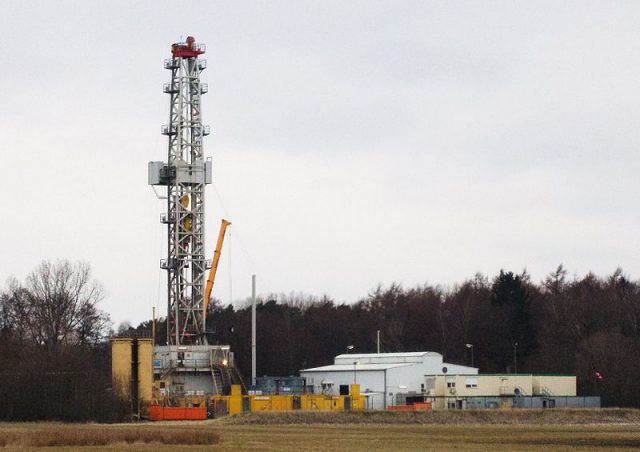Jones: the trembling town
Jones is a small city located in the state of Oklahoma, in the Central United States. In Science Magazine we can read that the town has one bar, three restaurants and nine churches1. It looks like the perfect place for a truly peaceful holiday, doesn’t it? Too bad that our perception of Jones’s tranquility can change after learning that the city has been home to at least 2547 earthquakes since 2008.

However, the state of Oklahoma was not that turbulent some years ago. From 1967 to 2000 and within the central and eastern United States, where Oklahoma is to be found, there used to be 21.2 magnitude 3 or greater earthquakes per year. Those were peaceful times. But later this value started rising and, from 2010 to 2012, more than 300 magnitude 3 or greater earthquakes ocurred2. In fact, between the years 2008 and 2013, the state of Oklahoma was the greatest contributor to central and eastern US seismicity, representing 45% of the total when no other state contributed more than 11 %3. What happened in those years? Katie Keranen and her group have a possible explanation: they have recently published a study relating this increase in Oklahoma’s seismicity with four of the high-rate disposal wells used in unconventional oil and gas production operations.
Let’s quickly review this type of resource extraction. First, a high-pressure fluid is injected into a well. If any of you is interested in having a glimpse at the most commonly used chemical components in hydraulic fracturing, you can start by following this link, which is a report by the Congressional Democrats. Anyway, this fluid fractures the rock that is hiding the oil or the gas, and facilitates the recovery of the resource. Afterwards, this waste water -which has a high salt content- needs to be treated and disposed of, and that’s what the disposal wells are for. Specifically, the four high-rate wells Keranen is referring to dispose of approximately 4 million barrels per month, injecting the waste water back into the ground.

How could this waste water injection cause earthquakes? The injected fluid can migrate quite long distances from the injection location, building up pressure on its way. As the pressure perturbation propagates, if it encounters any fault, and the orientation and stress conditions are appropriate, an earthquake can be triggered.
The authors of this paper developed a hydrogeological model which simulated injection into 89 wells, to study pore pressure changes at earthquake hypocenters. They calculated that the modelled pressure perturbation could propagate through 35 kilometers with an earthquake triggering threshold of around 0.07 megapascals. Thus, they defend that the fluid migration from the already mentioned four high-rate disposal wells is potentially responsible for the rising seismicity in the area surrounding Jones. In fact, they found that those four wells were capable of triggering approximately 20% of 2008 to 2013 central and eastern U.S. seismicity.
In any case” -you may think- “we are not talking about really big earthquakes, right?”. That is true. Many of the ones which have probably been induced by fluid injection are quite small and, according to the U.S. Geological Survey, some magnitude 5 earthquakes in the state of Colorado in 1967 were the greatest ones induced by this type of industry. “1967? That happened like a million years ago! Can we feel safe then?”. Well, not so long ago, in 2011 near Prague, Oklahoma, there was a 5.7 earthquake likely to have been induced by waste water injection3. And this article observes that the Nemaha fault, that runs through the states of Oklahoma, Kansas and Nebraska, is capable of hosting a magnitude 7 earthquake, presenting a potential hazard for the Oklahoma City metropolitan area.

Nowadays, in my opinion, too many important decisions are made considering only, or mainly, the economic aspects or benefits involved. In addition, controlling the fossil energy resources is one of the most powerful keys in the global “game of thrones” to be the strongest country.
Benjamin Franklin, one of the Founding Fathers of the United States, once said: “An ounce of prevention is worth a pound of cure”. Apparently he was talking about fire-prevention in Philadelphia, but I’m going to borrow his quote and say that much more research is needed in this area, despite the big profit it can generate. Measurements of pore pressure at a range of distances and better earthquake monitoring, for example, could help scientists to determine if, when, where and how fluid injection can trigger potentially dangerous earthquakes.
References
- Eric Hand (2014). Injection wells blamed in Oklahoma earthquakes. Science. 4;345(6192):13-4. doi: 10.1126/science.345.6192.13. ↩
- William Ellsworth (2013). Injection-induced earthquakes. Science. 12;341(6142):1225942. doi: 10.1126/science.1225942. ↩
- K. M. Keranen, M. Weingarten, G. A. Abers, B. A. Bekins, S. Ge (2014). Sharp increase in central Oklahoma seismicity since 2008 induced by massive wastewater injection. Science. 25;345(6195):448-51. doi: 10.1126/science.1255802. ↩
1 comment
[…] Que el fracking está cambiando el negocio petrolero (en sentido amplio) y hasta la geopolítica es innegable. Ahora bien, hay números que resultan alarmantes. Y si no, que se lo pregunten a los habitantes de Jones: the trembling town […]